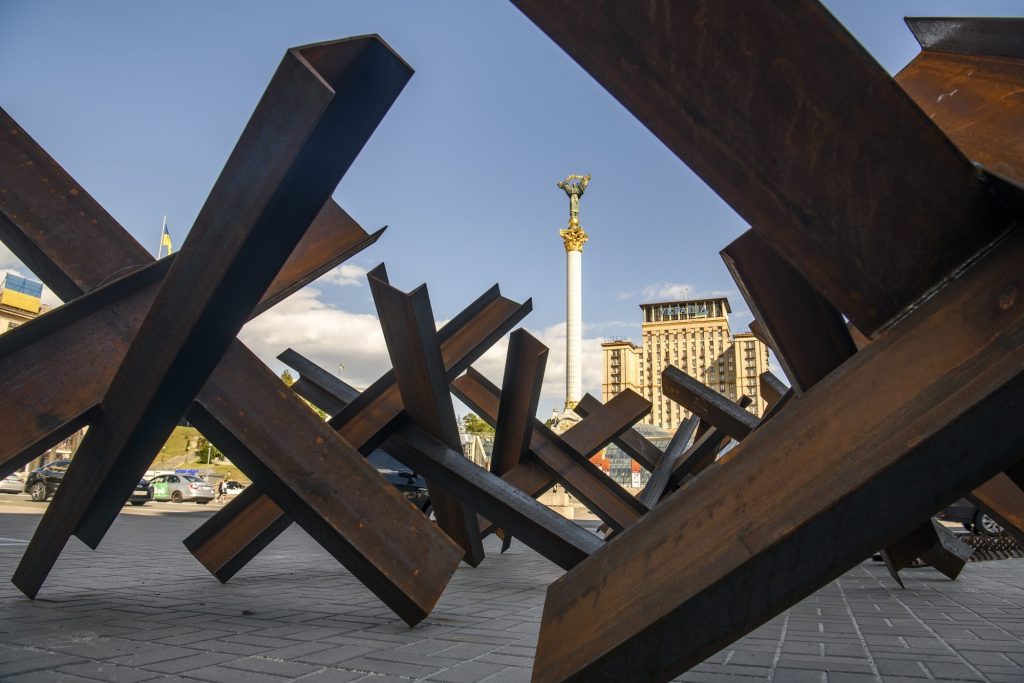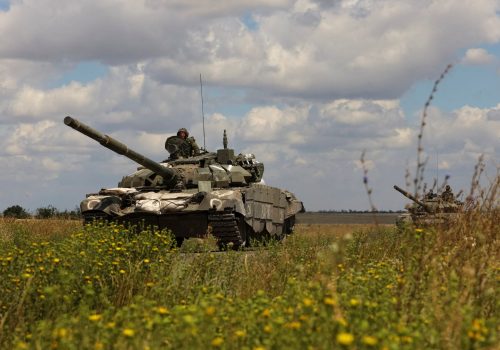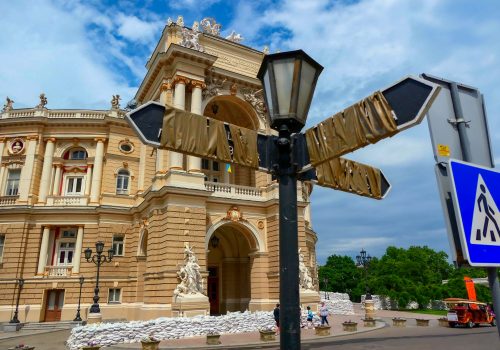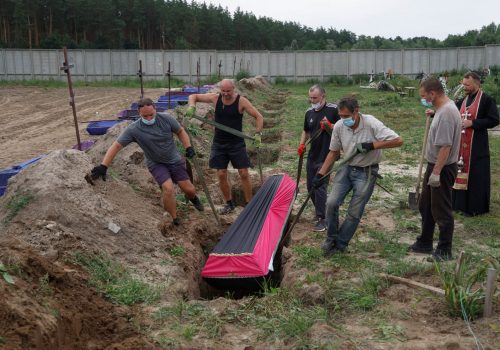The Russian invasion of Ukraine has dominated global headlines for the past six months. But beyond the endless harrowing images of death and destruction, a remarkable story of Ukrainian courage and resilience is unfolding that has to be seen to be truly appreciated.
Visiting wartime Ukraine is an extreme option that is certainly not for the faint-hearted. Indeed, many would likely find it inappropriate or unsuitable. Nevertheless, a trip to today’s Kyiv offers an opportunity to witness world history in the making while providing Ukrainians with meaningful moral and material support.
Having just returned from a two-week trip to the Ukrainian capital, I can recommend wartime Kyiv as an unforgettable destination for anyone who has an interest in history and is prepared to leave their comfort zone. Naturally, it is important to emphasize the serious security risks this involves. Russia’s invasion is ongoing and parts of Ukraine that are peaceful today may be subjected to some form of attack tomorrow. Having said that, during my visit in late July and early August, I often felt that I was in greater danger of being hit by an electric scooter than a Russian missile.
Stay updated
As the world watches the Russian invasion of Ukraine unfold, UkraineAlert delivers the best Atlantic Council expert insight and analysis on Ukraine twice a week directly to your inbox.
Reaching Kyiv has become inconvenient due to the cancellation of all flights to Ukraine. However, there are numerous different bus and train routes operating from Central European cities like Warsaw and Prague. If you are arriving from Western Europe, North America or beyond, it might be a good idea to plan a stopover stay in Central Europe before the final leg of your journey to the Ukrainian capital.
Upon arrival in Kyiv, I found it surprisingly similar to the peaceful city I had called home for much of the past two decades. To be sure, the mood and rhythm of the Ukrainian capital have changed since the Russian invasion began in February. There are fewer people about and more visible signs of poverty on the streets. A curfew is in place from 23:00 until 05:00, while regular air raid sirens continue to break up the daily routine.
The threat of aerial bombardment remains the greatest single danger facing residents and guests of the Ukrainian capital. Kyiv has a comparatively good air defense system with a strong record of intercepting Russian missiles, but airstrikes can and do happen. This helps fuel a mood of tension that serves as a permanent backdrop to daily life.
At the same time, with the frontlines of the war hundreds of kilometers away, there is also a sense of normality around town and a feeling that people are determined to enjoy life. Public transport is less crowded than in peacetime, but the excellent Kyiv metro system continues to operate on a reduced schedule. Taxi services are fully operational once again, as are banks, pharmacies, and most stores. The petrol shortages that led to limited mobility and long queues during the early months of the war are now long forgotten. Likewise, supermarkets are more or less fully stocked.
Downtown Kyiv is as colorful as ever, with many bars and cafes open for business and street vendors selling flowers, ice creams, and chilled drinks to passersby. Prices have risen sharply since the beginning of the war, but visitors with foreign currency will still find Kyiv a highly affordable destination due to the accompanying decline in the exchange rate for Ukraine’s hryvnia currency.
Eurasia Center events

Prior to the Russian invasion, Kyiv was first emerging as one of Eastern Europe’s gastronomic jewels. Despite the current wartime conditions, the Ukrainian capital remains a fantastic place to dine out. The large selection of excellent Georgian restaurants is particularly hard to beat, with superb Caucasian cuisine on offer at very competitive prices.
Summertime Kyiv remains an unrivalled strolling city with elegant boulevards and abundant park life as well as miles of stunning sandy beaches lining the Dnipro River. I was pleased but not at all surprised to note that Vladimir Putin’s genocidal war has done little to deter Kyiv’s dedicated fishing enthusiasts, who continue to line the riverbanks and Dnipro bridges in time-honored fashion.
There are enough reminders to make sure you never forget the close proximity of Europe’s largest armed conflict since WWII. This includes a strong police and military presence throughout the city. Parts of central Kyiv’s government district are closed off to the general public. You may be asked to show your passport at one of numerous remaining checkpoints. Despite these understandable security measures, the atmosphere remains strikingly friendly and surprisingly relaxed given the circumstances.
A fledgling wartime tourism sector is gradually emerging in and around the Ukrainian capital. Many visitors travel out to the Kyiv suburbs to witness the scenes of Russian war crimes and pay their respects to the victims. The city itself has several open air exhibitions featuring a range of captured Russian tanks and other weapons of war on display.
While these sights are all worth seeing, the real value of a visit to Kyiv comes from observing European history taking shape in real time. The war currently raging in Eastern Europe is likely to mark the final chapter in three hundred years of Russian imperial domination over Ukraine and confirm the country’s emergence as a genuinely independent European democracy. Given Ukraine’s status as the largest nation wholly located in Europe, this has profound implications for the entire continent.
Geopolitics aside, this is also a hugely compelling human story of ordinary people defending their country against overwhelming odds. For weeks in February and March, Kyiv was a fortress city under attack from advancing Russian troops. Like all Ukrainians, Kyivans are well aware that Putin seeks to extinguish Ukrainian statehood and erase Ukrainian identity. Visiting Kyiv at this time means standing in solidarity with them.
The entire notion of war tourism is often justifiably derided as exploitative and unethical, but taking a trip to today’s Kyiv is not about gawping at the horrors of war. It is an opportunity to personally witness one of the most remarkable stories in modern European history while also demonstrating support for a nation whose indomitable spirit has captured the imagination of the entire world. Ukrainians will welcome the additional tourist dollars, but they will be even happier to see that they are not alone.
Dr. Andreas Umland is an associate professor at the Department of Political Science at Kyiv-Mohyla Academy (NaUKMA) and an analyst at the Stockholm Centre for Eastern European Studies (SCEEUS) at the Swedish Institute of International Relations (UI).
Further reading
The views expressed in UkraineAlert are solely those of the authors and do not necessarily reflect the views of the Atlantic Council, its staff, or its supporters.

The Eurasia Center’s mission is to enhance transatlantic cooperation in promoting stability, democratic values and prosperity in Eurasia, from Eastern Europe and Turkey in the West to the Caucasus, Russia and Central Asia in the East.
Follow us on social media
and support our work
Image: Anti-tank obstacle on Independence Square in downtown Kyiv, Ukraine, May 24, 2022 (Photo by Maxym Marusenko/NurPhoto)




